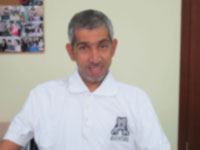Hamad Bin Salem Albadi - Amyotrophic lateral sclerosis (Oman) Posted on May 28, 2012
Name: Hamad Bin Salem Albadi 
Sex: Male
Country: Oman
Age: 40
Diagnosis: ALS (Amyotrophic lateral sclerosis)
Admission Date: April 15, 2012
Days Admitted to Hospital: 26
Identifying Information:
Hamad has suffered from progressive myasthenia in the arms and legs for the past 3 and a half years without an obvious cause. He has had a lot of difficulty with grasping small items because of the impairment to the fine motor skills and when Hamad went to his local hospital to get treatment for the symptoms, the MRI and EMG examination results revealed a neurogenic injury. He was diagnosed with motor neuron disease and amyotrophic lateral sclerosis and was prescribed Riluzole as well as participating in physical rehabilitation therapy. But despite this, the symptoms continued to get worse and about two years ago Hamad developed muscle atrophy in the legs but he was still able to walk unassisted at that time. Hamad had difficulty drinking and would occasionally choke. Because of the weakness in the legs he is currently unable to walk unassisted and because of the weakness in his arms, it is difficult for Hamad to take care of himself.
Nervous System Examination:
Hamad was alert and his mental faculties were good. His speech was unclear. The memory, calculation abilities and orientation were normal. Both pupils were equal in size and their diameter was 2.5mms. Both eyeballs could move flexibly and the pupils reacted normally to light stimulus. The forehead wrinkle pattern was symmetrical. The tongue could only extend out as far as the lips. There was mild atrophy and tremors in the tongue. The uvula was shifted to the left side. The teeth were shown without deflection. The cheeks could be expanded normally. The raising ability of the soft palate was weak. There was obvious muscle atrophy in the bilateral supraspinatus, infraspinous, deltoids, forearm muscles, interosseus muscles of both hands, small and big thenar, pectoralis major muscle, intercostal respiratory muscles, quadriceps femoris muscle and hamstrings. The muscle strength of the right upper limb's proximal-end was level 3; the muscle strength of the right upper limb's distal-end was level 3-. The muscle strength of the left upper limb's proximal-end was level 3; the muscle strength of the left upper limb's distal-end was level 3+. The holding power of the right hand was level 2-; the holding power of the left hand was level 2+. The muscle strength of the right lower limb was level 3; the muscle strength of the left lower limb was level 3+. The muscle tone of all four limbs was almost normal. The bilateral deep and shallow sensation was almost normal. The tendon reflexes of both upper limbs were slightly active. The bilateral patellar tendon reflex was active. The bilateral Achilles tendon reflex was almost normal. The bilateral abdominal reflexes were slightly elicited. The bilateral jaw and palm jaw reflex, left side Hoffmann's sign and Rossolimo's sign were positive. Right side Hoffmann's sign and Rossolimo's sign were neutral. The left side Babinski's sign was positive. The right side Babinski's sign was neutral. Hamad had difficulty with the finger-to-nose test, the rapid rotation test, and the digit opposition test. He couldn't finish the heel-knee-shin test for either leg smoothly. He couldn't cope with the Romberg's sign test.
Treatment:
We initially gave Hamad a complete examination. He received treatment to improve the immune system and he was put on non-invasive mechanical assisted ventilation. He received treatment to improve the blood circulation in order to increase the blood supply to the damaged neurons, promote their repair and to nourish them. He was also given daily physical rehabilitation training to promote the recovery of the motor functioning.
Post-treatment:
Hamad's mood has improved. The respiratory function has improved. The breathing sounds in the lower region of both lungs have strengthened. The finger tip oxyhemoglobin saturation is 97-98% with use of a non-invasive mechanical ventilator. The finger tip oxyhemoglobin saturation is 96-98% without use of a non-invasive mechanical ventilator. The condition of the skin on the shoulders and back has clearly improved. The holding power of both hands and the muscle strength of the lower limbs increased by 1 level. Hamad can walk for a longer period of time. The movements of the tongue are more flexible. The swallowing ability has improved.
